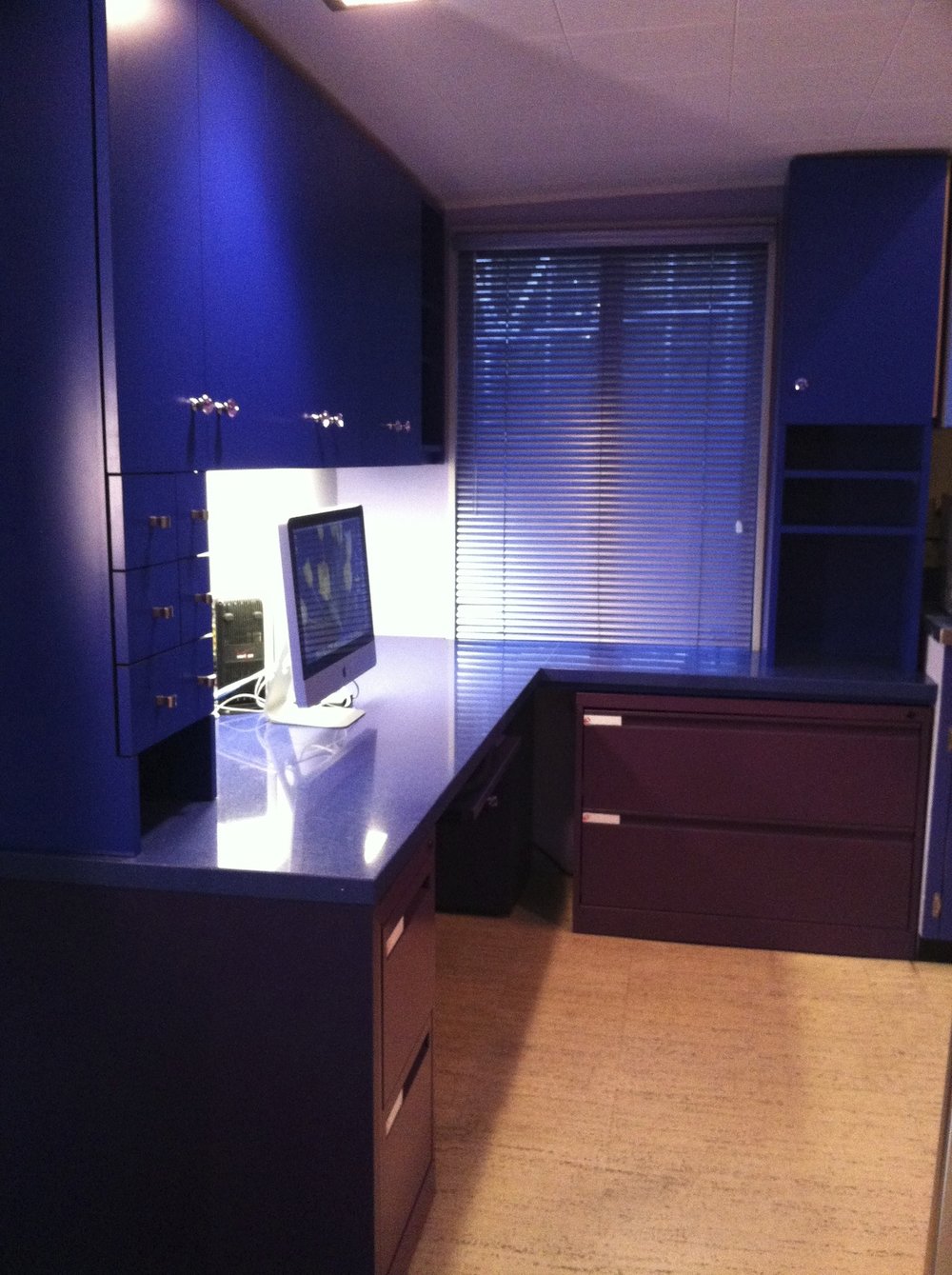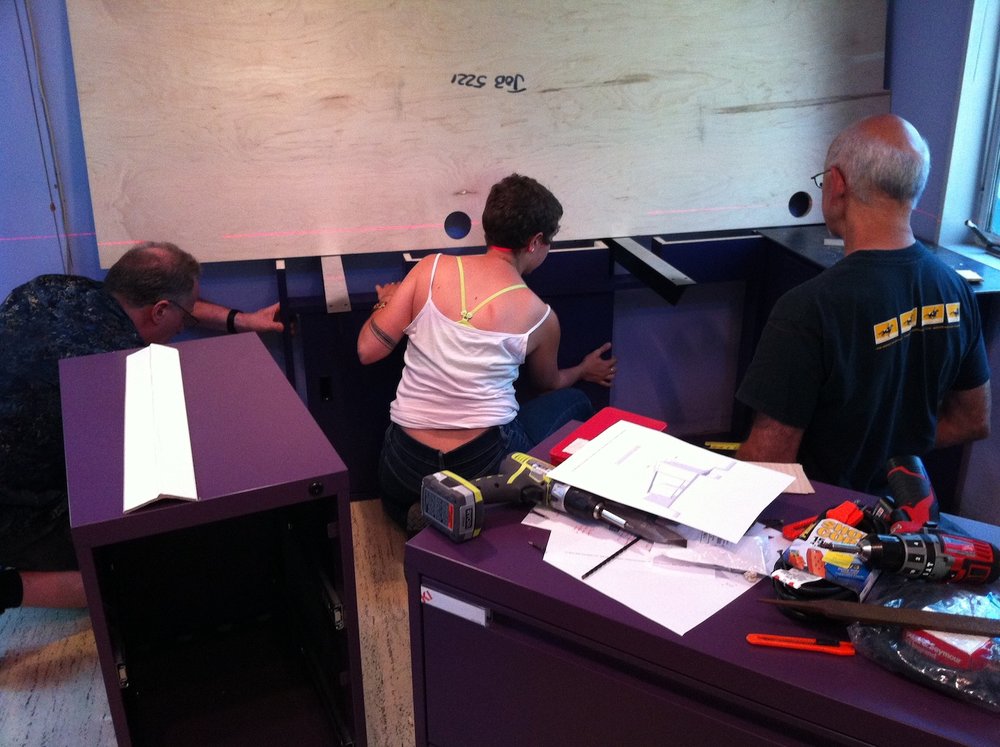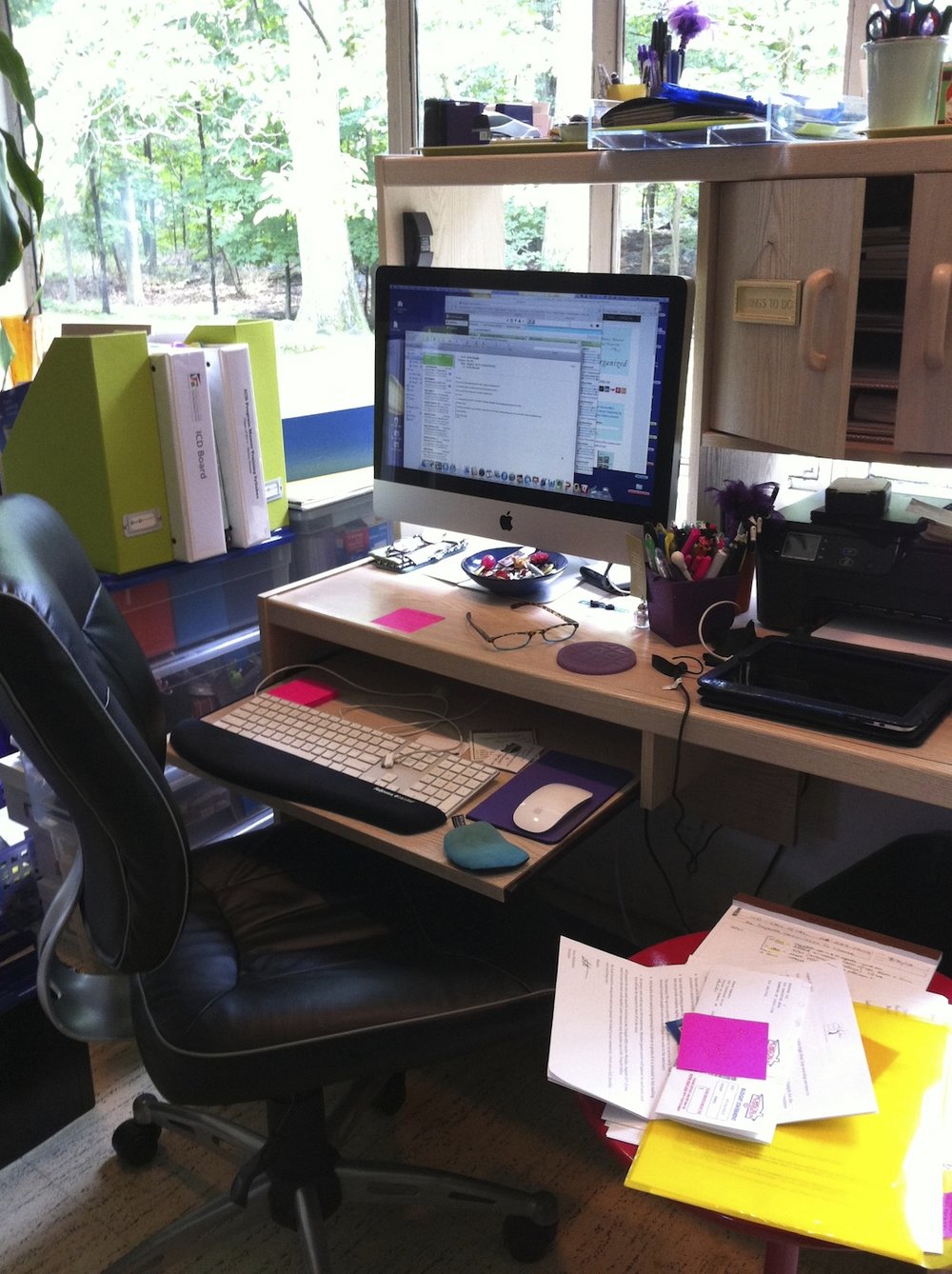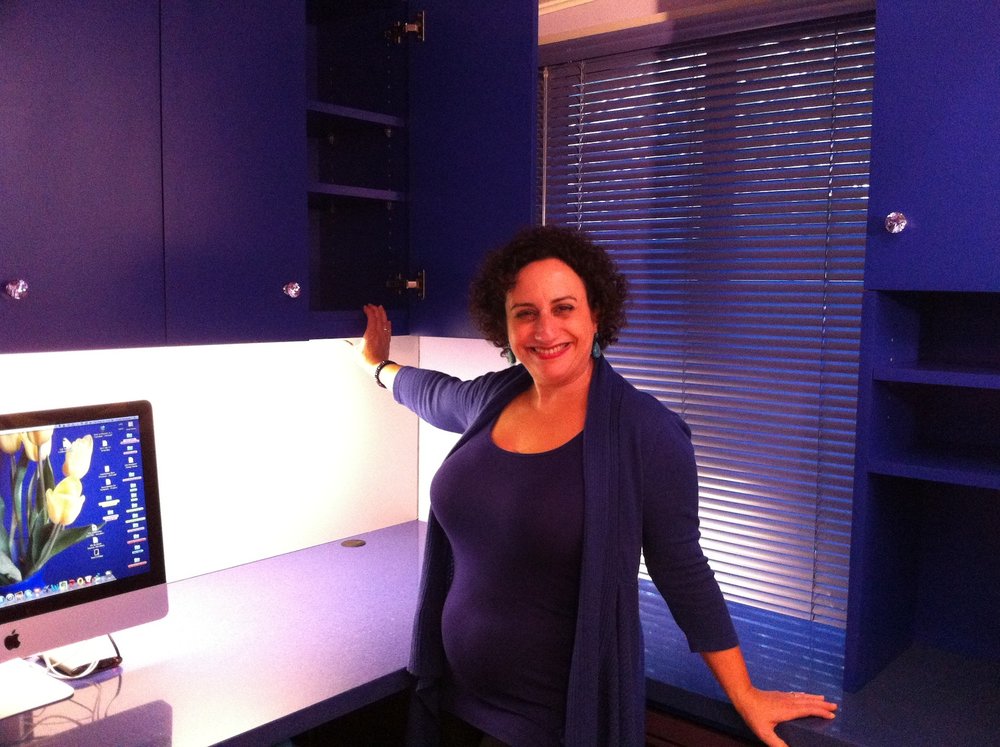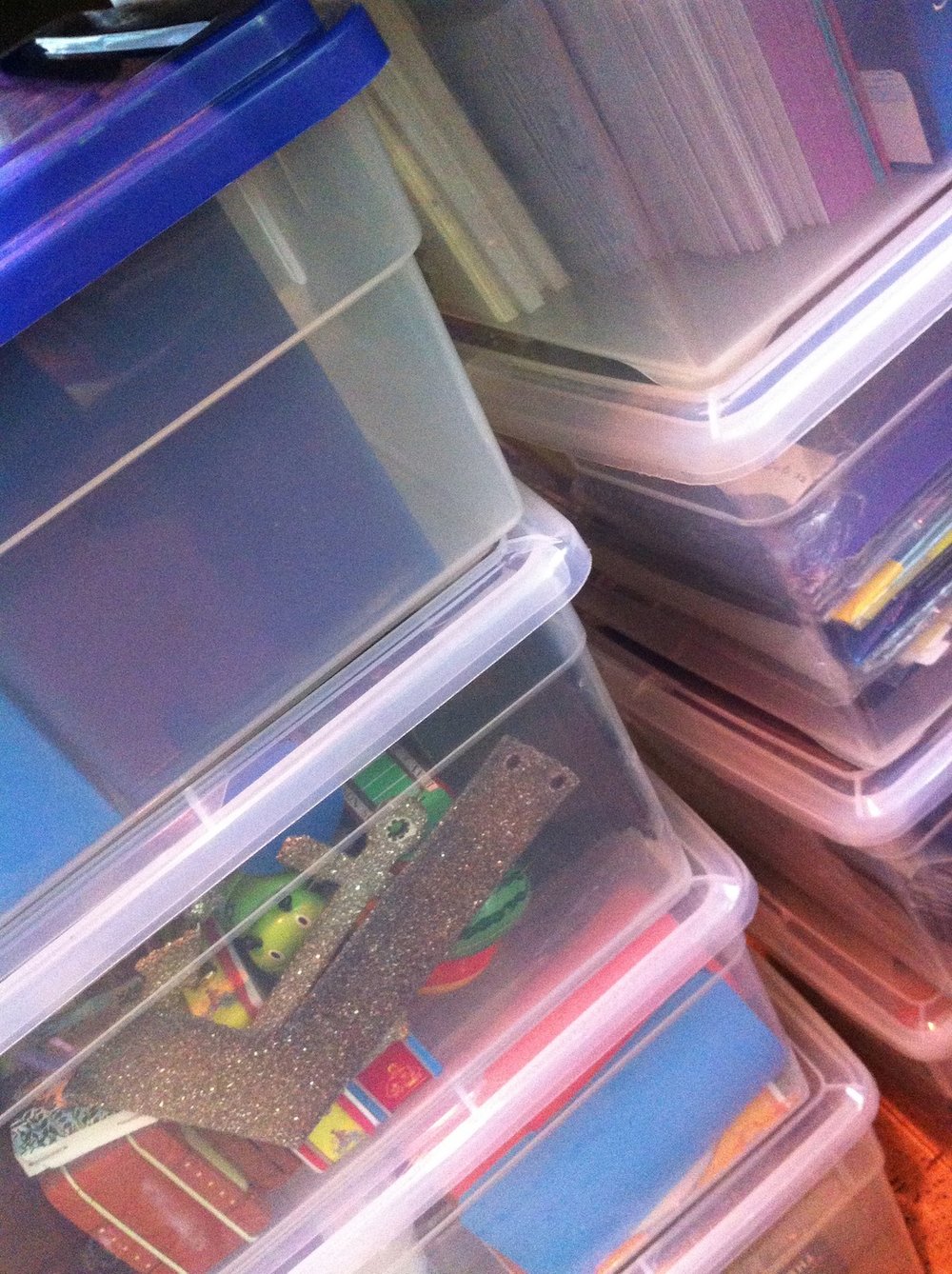2020 has been the year of Zoom, and with it came an abundance of desk time. It’s a good thing that this professional organizer loves being in her home office. It is the place I have virtual organizing sessions with clients, write blog posts, attend workshops, pay bills, and connect with family, friends, and colleagues. My space reflects a balance of the elements that are most important to me. When I’m here, reminders that help me focus, be productive, feel calm, creative, grateful, and supported surround me.
Organization at its best happens when our environment supports what we need and want to do. After all, when you’re struggling to find a pen that works, a paper to jot a note onto, staples to replenish your stapler or a cord to recharge your device, that searching adds undue stress in your life. When your surfaces are covered with non-essentials, they detract rather than help you focus on your intentions.
If your space lacks comfort, your body and mind will become exhausted. And if your place is void of the “you” factor, it won’t honor your uniqueness.
As we wrap up one year and head into the next, this is an excellent time to consider balance and its role in your physical environment. While I’m sure you have your list of what makes you feel organized and supported in your space, I thought you’d enjoy this behind-the-scenes view of my office and the elements that help me.
If you’re curious, you can read and see more photos of how my office space came to be in Dreams Need Help, Too. Continue reading for a behind-the-scenes look at Linda’s office.
10 Elements That Add Balance
1. Inspiration
Inspiration is present in many forms. There are the small signs or words I display around my desk, like the Anna Quindlen quote card that says, “I wish I had treasured the doing a little more and the getting it done a little less.”
My favorite inspirational books are perched visibly on the shelves, including Mindset by Carol Dweck. Other favorites include I’ll Carry the Fork by Kara Swanson, Mindfulness by Ellen Langer, Emotional Intelligence by Daniel Goleman, Resilience by Linda Graham, and The Little Book of Hygee by Meik Wiking.
These visuals encourage me to continue learning, be creative, and focus on what is meaningful.
2. Technology
My Apple device trio- the iMac, iPad, and iPhone helps me communicate and stay organized. They sync with each other, which helps with productivity. If a new contact or appointment is entered on my phone, it automatically syncs with my iMac and iPad. One of the keys to using technology is having confidence in your devices and knowing where and how to access the vast amount of information you are storing.
Tech balance comes from organizing my e-files for easy retrieval and having physical and cloud-based auto back-up systems. Over the years, I’ve become increasingly dependent on technology, which has its pros and cons. One way I manage that balance is by minimizing the beeps and dings so my devices don’t interrupt me when I’m working.
3. Comfort
While I’m committed to having non-desk time for activities like walking, yoga, or meditation, I’m actually at my desk a significant amount of the time. Part of balance includes being physically comfortable.
A few things make my desk life better. I have gel-filled wrist rests for my keyboard and mouse, a purple velvet footstool for my short legs, and a navy blue velour desk chair that is soft to the touch. Good-feeling fabrics and textures matter to me.
My lighting is also comfortable with various sources, including natural light. Don’t underestimate the value of improving a few physical office essentials to increase comfort. Your body and mind will thank you.
“Organization at its best happens when our environment supports what we need and want to do.”
4. Organization
I can’t ignore the value of the physical organization of papers, files, and supplies in feeling balanced. My office was designed to hold all the items I use regularly.
There are filing cabinets for papers, open slots for ongoing projects, and closed cabinets to store supplies like the label maker, paper pads, printer cartridges, and notecards. There are drawers for stamps, mailing labels, and eyeglasses.
Everything has a place and is at my fingertips. Pens, stapler, sticky notes, scissors, and other frequently used supplies are visible and contained on my desk.
5. Time
Managing myself involves being time-aware. This awareness enables me to be punctual for appointments, focus on projects, take breaks, and shift gears. The clocks and timers in my office support boundaries and balance.
My tech devices display the time digitally. However, it is my large yellow analog wall clock that I rely on most. I interpret time most easily when I can see the visual representation of time moving. I also use the Time Timer and the alarm setting on my iPhone Clock app to manage my time.
6. Family
When we talk about work, the phrases work-life balance or work-family balance often emerge. Having a space that inspires and supports your work is great. However, remembering that life isn’t just about work is key.
Spending time with the people I love is essential. On display are photos of happy faces snuggled together and beautiful moments spent with my husband and kids. They exude love. My family lifts my heart and brings balance, meaning, and joy into my life.
“Having a space that inspires and supports your work is great. However, remembering that life isn’t just about work is key.”
7. Color
Color affects my mood. Even as a young girl, the color was how I interpreted the world. When curious about a place or thing, my first question was often, “What color is it?” By age five, my favorite color was purple, and it still is.
When it came time to design my office, I wanted to incorporate my color. I combined different violet hues, such as the red-violet pullout keyboard tray, the blue-violet cabinets, the muted purple filing cabinets, and the blue-fleck quartz desktop.
Being surrounded by my favorite color makes me feel happy, grateful, and balanced. How does color affect you?
8. Sparkle
Color is great, but color with sparkles is even better. I’ve always responded to light. There’s something so lovely about how sparkly things like glitter, glass, and other shiny objects reflect light. The undulating lightness brings balance and some whimsy to the darkness.
When I look around the office, my eye catches glimpses of shine from objects like the lavender glass cabinet knobs, the silver glitter-covered Eiffel Tower, or the purple sparkle pen cup.
Who says we can’t find balance in the sparkles?
9. Toys
Toys make me think about play, which is the opposite of work. A long tray of toys, which I affectionately call fidgets, is displayed under my computer screen. They include miniature buttons, clothespins, Legos, trolls, rubber ducks, maracas, egg timers, and other tiny objects. They represent a variety of colors, textures, and messages.
Why are they there? And what do they have to do with balance? When I’m in a meeting or on a call, playing with the objects helps me focus. Fiddling around in this tactile way improves my concentration. The other aspect has to do with my appreciation of small things and fun. My fidget collection provides a balance of focus and whimsy.
10. Nature
For me, feeling aliveness within extends into being surrounded by living things, like plants. So much is quiet and still in my office. Including greenery or fresh flowers adds vibrancy and balance to my space.
My oldest daughter, Allison, gave me a beautiful wooden stand that displays a miniature ceramic pot and an air plant. The plant is the sweetest little thing, and it makes me think of my daughter and how she has blossomed.
The tiny plant also reminds me to nurture and care for it and others. The balance lies in doing and not doing, watering but not overwatering, and nurturing but not smothering.
As we end one year and shift to the new one, how will you bring balance into your life? Have you considered the ways your space supports or disrupts your balance? What one change can you make to improve your physical space? I’d love to hear your thoughts. I invite you to join the conversation.



















